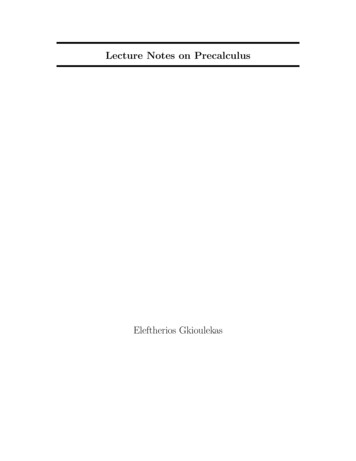
Transcription
Lecture Notes: LinguisticsEdward Stabler, Winter Human Language Families Map.PNG
Lecture notes:(page numbers will change during the quarter)1 The nature of human languages12 Morphology113 Syntactic constituents and categories234 The anatomy of a phrase335 Heads and non-recursive combinations416 Sentences and first glimpse of movement537 Clauses, tense, and questions638 Review: The perspective so far759 Semantics: What it all means8510 Semantic perspectives on determiners etc9311 Names, pronouns and binding9912 Phonetics10313 Phonology introduced11514 Phonemes and rules of variation12515 Stress and intonation13916 Universals, and review145i
Stabler - Linguistics 20, Winter 2014ii
Linguistics 20Introduction to LinguisticsLecture MW2-4 in Bunche 2209AOffice Hours: M4-5, by appt, or stop byProf. Ed StablerOffice: Campbell 3103fstabler@ucla.eduPrerequisites: noneContents: What are human languages, such that they can be acquired and used as theyare? This class surveys some of the most important and recent approaches to this question,breaking the problem up along traditional lines. In spoken languages, what are the basicspeech sounds? How are these sounds articulated and combined? What are the basic units ofmeaning? How are the basic units of meaning combined into complex phrases? How are thesecomplexes interpreted? These questions are surprisingly hard! This introductory survey canonly briefly touch on each one.Text: Linguistics: An introduction to linguistic theory. V. Fromkin (ed.), which is availablenew and used here, here, here, here here, and here.Notes and homework will be posted at irements and grades: There will be 4 homework assignments, assigned on Wednesdaysand due the following Monday in lecture, at the beginning of class. The homework will begraded by the TAs and discussed in the discussion sections. There will be 3 mid-term quizzesduring the quarter, and an in-class final exam. The exams will be analytic problems verysimilar to those given in the homework.The final exam will have 4 parts, 1 part corresponding to each of the 3 earlier quizzes, and 1part for the new material. So for each of the first 3 parts of the class, we will have 2 grades:the original quiz and the grade on corresponding section of the final. Your grade will be thehigher of those 2. The part of the final on new material will be worth 16%. The idea is tomake the quizzes much less stressful (and a better indication of what you have learned) thanjust 1 or 2 huge exams. You get a second shot at first 3 parts of the material.Quiz and final exam dates (all held in class) are posted on the /20/ ,where lecture notes, and reading assignments will also be posted each week.iii
Stabler - Linguistics 20, Winter 2014iv
Lecture 1The nature of human languagesThese lecture notes will contain the required reading for the class, and for supplementaryreading the text edited by Fromkin (2000), Linguistics: An Introduction to Linguistic Theory,is recommended (That text was written specifically for this class, but it has 747 pages!) Inthis class, I will be clear about which things you are expected to understand completely –basically, it will be everything in these notes. This lecture is based on Chapter 1 of Fromkin,but if you compare you will see that we select just some parts and extend other parts.Human language is the most familiar of subjects, but most people do not devote muchtime to thinking about it. The basic fact we start with is this: I can make some gestures thatyou can perceive (the marks on this page, or the sounds at the front of the classroom), andalmost instantaneously you come to have an idea about what I meant. Not only that, youridea about what I meant is usually similar to the idea of the student sitting next to you. Ourbasic question is: How is that possible? And: How can a child learn to do this?1.11.31.41.51.6Introduction . . . . . . . . . . . .Productivity, Zipf’s law .Creativity . . . . . . . . . . . . . .Flexibility . . . . . . . . . . . . . .Words and rules . . . . . . . .Summary . . . . . . . . . . . . . . .124558The account of how sounds relate to meaning separate parts (which you may have seenalready in the syllabus), reasons that will not be perfectly clear until the end of the class:1. phonetics - in spoken language, what are the basic speech sounds?2. phonology - how are the speech sounds represented and combined?3. morphology - what are words? are they the basic units of phrases and of meaning?4. syntax - how are phrases built from those basic units?5. semantics - how is the meaning linguistic units and complexes determined?A grammar is a speaker’s knowledge of all of these 5 kinds of properties of language. Thegrammar we are talking about here is not rules about how one should speak (that’s sometimescalled “prescriptive grammar”). Rather, the grammar we are interested in here is what thespeaker knows that makes it possible to speak at all, to speak so as to be understood, and tounderstand what is said by others. The ideas are relatively new: that an appropriate grammarwill be a component of psychological and neurophysiological accounts of linguistic abilities,and that it should be divided into something like the 5 components above. But our descriptivegoals are similar to ancient ones.Considering the first two components of grammar listed above, note the indication that wewill focus on spoken languages, and particularly on American English since that is the languagewe all share in this class. But of course not all human languages are spoken. There are manysign languages. American Sign Language (ASL) is the most common in the US, but now, atthe beginning of 2014, the online Ethnologue1 lists 137 sign languages. The phonetics andphonology of sign languages involves manual and facial gestures rather than oral, vocalic ones.The “speech” in these languages is gestured. As we will see, the patterns of morphology, syntax,1 http://www.ethnologue.com/show family.asp?subid 23-161Pān.ini (600-500 BCE) wrote a grammarof 3,959 rules for Sanskrit, and is said tohave been killed by a lion. He is the onlylinguist I know of who has been killed bya lion. And he is the only linguist I knowof who has been put on a postage stamp.
Stabler - Linguistics 20, Winter 2014and semantics in human languages are remarkably independent of the physical properties ofspeech, in all human languages, and so it is no surprise that the morphology, syntax, andsemantics of sign languages exhibit the same kinds of structure found in spoken languages.In each of the 5 pieces of grammar mentioned above, there is an emphasis on the basic units(the basic sounds, basic units of phrases, basic units of meaning), and how they are assembled.I like to begin thinking about the project of linguistics by reflecting on why the problemsshould be tackled in this way, starting with “basic units.” There is an argument for thatstrategy, which I’ll describe now.1.1Productivity, and Zipf’s lawProductivity: Every human language has an unlimited number of sentences.Using our commonsense notion of sentence (which will be refined with various technical concepts later), we can extend any sentence you choose to a new, longer one. In fact, the numberof sentences is unlimited even if we restrict our attention to “sensible” sentences, sentences thatany competent speaker of the language could understand (barring memory lapses, untimelydeaths, etc.).This argument is right, but there is a stronger point that we can make. Even if we restrictour attention to sentences of reasonable length, say to sentences with less than 50 words orso, there are a huge number of sentences. Fromkin (2000, p.8) says that the average personknows from 45,000 to 60,000 words. (I don’t think this figure is to be trusted! For one thing,it depends on what a word is, and on what counts as knowing one – both tricky questions.)But suppose that you know 50,000 words. Then the number of different sequences of thosewords is very large. Of course, many of those word sequences are not sentences, but quite afew of them are, so most sentences are going to be very rare. Empirical sampling confirmsthat this is true. What is more surprising is that even most words are very rare.To see this, let’s take a bunch of newspaper articles (from the ‘Penn Treebank’) – about10 megabytes of text from the Wall Street Journal – about 1 million words. As we do in astandard dictionary, let’s count am and is as the same word, and dog and dogs as the sameIf word w is the n’th most frequent word, word, and let’s take out all the proper names and numbers. Then the number of differentthen we say its ‘rank’ r(w) n. Zipf words (sometimes called ‘word types’, as opposed to ‘word occurrences’ or ‘tokens’) in these(1949) proposed that in natural texts the articles turns out to be 31,586. Of these words, 44% occur only once. If you look at sequencesfrequency of w,of words, then an even higher proportion occur only once. For example, in these newspaperarticles 89% of the 3-word sequences occur just once. Since most sentences in our average dayk.freq(w) r(w)αhave more than 3 words, it is safe to conclude that most of the sentences you hear, you willonly ever hear once in your life.for some constants k and α.1008060402050001000015000200002500030000Fig. 1.1: Word frequency vs rankThe fact that most words are rare, but the most frequent words are very frequent, is oftencalled Zipf ’s law. For example, with those newspaper articles again, plotting the actualfrequencies of the most frequent word to the least frequent word gives us the graph shownin Figure 1.1. The top of the curve gets chopped off so that I can fit it on the page! Here,word 1 on the x-axis is the most frequent word, the, which occurs 64628 times – off the topof the graph. Word 10 is say, which only occurs 11049 times – still off the top of the graph.Word 2500 is probe, which occurs only 35 times and so it is on the displayed part of the curve.Words 17,606 to 31,586 are all tied, occurring only once – these are words like zigzag, zealot,yearn, wriggling, trifle, traumatize,. . . You have heard all these words, and more than once,but that’s because you’ve heard many more than a million words. The surprising thing is that2
Stabler - Linguistics 20, Winter 2014as you increase the sample of texts, Zipf’s law stays the same: new unique words appear allthe time. Zipf’s law says that the frequencies in this plot drop off exponentially. This is thereason that most words are rare. Given Zipf’s law about word frequencies, it is no surprisethatmost sentences you hear, you only hear once.1.2CompositionalityHow can people understand so many sentences, when most of them are so rare that they willonly be heard once if they are heard at all? Our understanding of exactly how this could worktook a great leap early in this century when mathematicians noticed that our ability to dothis is analogous to the simpler mathematical task of putting small numbers or sets togetherto get larger ones:It is astonishing what language can do. With a few syllables it can express anincalculable number of thoughts, so that even a thought grasped by a terrestrialbeing for the very first time can be put into a form of words which will beunderstood by someone to whom the thought is entirely new. This would beimpossible, were we not able to distinguish parts in the thought corresponding tothe parts of a sentence, so that the structure of the sentence serves as an image ofthe structure of the thought. (Frege, 1923)The basic insight here is that the meanings of the limitless number of sentences of a productivelanguage can be finitely specified, if the meanings of longer sentences are composed in regularways from the meanings of their parts. We call this:Semantic Compositionality: New sentences are understood by recognizing the meaningsof their basic parts and how they are combined.This is where the emphasis on basic units comes from: we are assuming that the reason youunderstand a sentence is not usually that you have heard it and figured it out before. Rather,you understand the sentence because you know the meanings of some basic parts, and youunderstand the significance of combining those parts in various ways.We analyze a language as having some relatively small number of basic units, together withsome relatively few number of ways for putting these units together. This system of parts andmodes of combinations is called the grammar of the language. With a grammar, finite beingslike humans can handle a language that is essentially unlimited, producing any number ofnew sentences that will be comprehensible to others who have a relevantly similar grammar.We accordingly regard the grammar as a cognitive structure. It is the system you use to“decode” the language.In fact, human languages seem to require compositional analysis at a number of levels:speech sounds are composed from basic articulatory features; morphemes from sounds; wordsfrom morphemes; phrases from words. We will see all this later. The semantic compositionalityis perhaps the most intriguing, though. It is no surprise that it captured the imaginations ofphilosophers of the early 1900’s (especially Gottlob Frege, Bertrand Russell, Ludwig Wittgenstein). In effect, a sentence is regarded as an abstract kind of picture of reality, with theparts of the sentence meaning, or referring to, parts of the world. We communicate by passingthese pictures among ourselves. This perspective was briefly rejected by radically behaviorist3
Stabler - Linguistics 20, Winter 2014approaches to language in the 1950’s, but it is back again in a more sophisticated form – moreon this when we get to our study of meaning, of “semantics.”From Barwise and Perry (1983). Here the words mirror the visual scene, but how often does that happen?1.3Another fundamental: “creativity”Meaningful productivity is explained by compositionality, and compositionality bringswith it the emphasis on basic units and how they are combined. These notions should not beconfused with another idea that is often mentioned in linguistic texts, and in this quote fromthe well-known linguist Noam Chomsky:[The “creative aspect of language” is] the distinctively human ability to expressnew thoughts and to understand entirely new expressions of thought, within theframework of an “instituted” language, a language that is a cultural productsubject to laws and principles partially unique to it and partially reflections ofgeneral properties of the mind. (Chomsky, 1968)Chomsky carefully explains that when he refers to the distinctive “creativity” of humanlanguage use, he is not referring to productivity or compositionality. He says that althoughlinguists can profitably study (productive, compositional) cognitive structures like those foundin language, our creative use of language is something that we know no more about than didthe Cartesian philosophers of the 1600’s:When we ask how humans make use of . cognitive structures, how and why theymake choices and behave as they do, although there is much that we can say ashuman beings with intuition and insight, there is little, I believe, that we can sayas scientists. What I have called elsewhere “the creative aspect of language use”remains as much a mystery to us as it was to the Cartesians who discussed it.(Chomsky, 1975, p138)Here the point is that we humans are “creative” in the way we decide what to say and do.Chomsky suggests that we produce sentences that are in some sense appropriate to the context,4
Stabler - Linguistics 20, Winter 2014but not determined by context. Our behavior is not under “stimulus control” in this sense.What we say depends in complex ways on our internal, psychological states which representthe context in various ways, still poorly understood. Chomsky (2014, p4) says “There has beengreat progress in understanding the finite means that make possible infinite use, but the latterremains largely a mystery.”Regardless of whether we accept Chomsky’s scepticism about accounting for why we saywhat we do when we do, he is right that this is not what most linguists are trying to account for.This is an important point. What most linguists are trying to account for is the productivityand compositionality of human languages. The main question is: What are the grammars ofhuman languages, such that they can be acquired and used as they are?1.4One more fundamental: flexibility and changeOne thing that the first quote from Chomsky suggests is that language has a certain flexibility.New names become popular, new terms get coined, new idioms become widely known – theconventional aspects of each language are constantly changing. We are inventing the languageall the time, extending it in ways that are not predicted simply by the possibility of newcompositions from familiar elements (productivity and compositionality). Linguists have beenespecially interested in what remains constant through these changes, the limitations on theflexibility of human languages. It is easy to see that there are some significant limitations,but saying exactly what they are, in the most general and accurate way, is a challenge. Wecan adopt a new idiom naturally enough, at least among a group of friends, but it would notbe natural to adopt the convention that only sentences with a prime number of words wouldget spoken. This is true enough, but not the most revealing claim about the range of possiblehuman languages. You can name your new dog almost anything you want, but could you giveit a name like -ry, where this must be part of another word, like the plural marker -s (as indogs), or the adverbial marker -ly (as in quickly)? Then instead of Fido eats tennis balls wouldyou say eatsry tennis balls or dory eat tennis balls or eats tennisry balls or what? None of theseare natural extensions of English. What kinds of extensions really get made and adopted byothers? This is partly a question of language learning, and partly a sociological question abouthow groups come to adopt a new way of speaking.1.5Words and rulesIf you have never studied language, the common idea is that the atoms of a language are itswords. To learn a language, you learn the words and the rules for putting them together. Let’sbegin with this idea. Fromkin (2000,p.26) says the following sentence from Shakespeare has13 words (12 different words, since 1 t7a8schoolmaster9for10the11fair12Bianca13All of these words are meaningful, and some of them are complex in the sense that theirmeanings are composed from meanings of their parts:(1) a compound is a word that has other words as parts,like school-master or looking glass5
Stabler - Linguistics 20, Winter 2014(2) a word can be composed of a root (or “base”) together with 0 or more affixeslike friend-s, promis-ed, care-ful-ly(an affix is a prefix or suffix – and some other possibilities are mentioned later)Why is -ed a suffix of promised, but pr- is not a prefix? The standard answer is:(3) A morpheme is the smallest meaningful unit in a language, and(4) Roots and affixes are morphemes.So -ed is an affix because it means Past, but pr is not a morpheme of any kind because it isnot meaningful. So the morphemes of the first sentence are these:The friend -s promis -ed to inquire care -ful -ly about a school -master for the fair Bianca12345 6789 10 11 12 131415 16 1718But we cannot understand definitions (1) or (2) without saying what a word is.So, what is a word? Fromkin (2000,p25): “Words are meaningful linguistic units that can becombined to form phrases and sentences.” But all morphemes are by definition meaningful, andthey can be combined to form phrases – but we are told (p.26) that words are not the smallestunits of meaning. So what is a word? One standard idea is that words are meaningful unitsthat can be ‘freely reordered’ (Fromkin 2000, p.320). Prefixes and suffixes are morphemes thatcannot ‘occur freely’ in this sense – they are sometimes said to be ‘bound’. Words can ‘stand ontheir own’. Of course, phrases and sentences like the one dissected into 17 different morphemesabove, are meaningful units that can stand on their own too. We see that when roots andaffixes are combined, as in care-ful-ly or promis-ed, the result is a word that contains manymorphemes. Two words can combine as in school-master to form a new word that contains twowords that are each morphemes. This is a ‘compound’ word. But when Shakespeare combinesthe 16 words to form our example sentence about Bianca, although this is a meaningful unitthat can occur freely, it is not a word. So let’s tentatively adopt this definition:(5) A word is a morpheme, or a complex of roots and affixes, or a compound, that canoccur freely.To understand this definition exactly, we would need to explain more carefully what it means“to occur freely.” This interesting idea is not easy to pin down. What is special about the breaksbetween words, which we do not find between roots and affixes (and perhaps not between thewords in a compound)? There are various ideas about this, but let’s rely on our intuitions forthe moment.1.5.1Roots and affixesWe find another interesting connection between morphemes and pronunciation when we lookmore carefully. For example, notice that our first example contained the past tense morphemethat is usually spelled “-ed”, pronounced [t]:k@ fôEnd -z "pôamIs -t tu In"kwaIô keô -f@l -li. . .The friend -s promis -ed to inquire care -ful -ly. . .12345 6789 10. . .Looking at a wider range of examples, we see that there are other past tense forms. Pronouncing the following examples, you will hear 3 different pronunciations. (We use a phoneticalphabet to indicate speech sounds, as dictionaries do. This notation will be introduced later.– For now, it is enough to hear the different pronounciations of the past tense.)6
Stabler - Linguistics 20, Winter dnER-@dfeR-@dThe way the past tense is pronounced is not random! We will consider this more carefullylater. These variant pronunciations of the morpheme are sometimes called allomorphs – thatjust means: alternative form of the morpheme.1.5.2Are irregular forms complex?Many English verbs have irregular past tense forms that are not root suffix combinations,some of them falling into groups like this:i. blow, grow, know, throw, draw, withdraw, flyii. take, mistake, shake, forsakeiii. bind, find, grind, windiv. bend, send, spend, lend, buildv. swear, tear, wear, bear, get, forgetvi. keep, sleep, sweep, weep, creep, leap, feel, deal, mean, dream, leave, losevii. ring, sing, spring, drink, shrink, run, swim, beginviii. sink, stink, spin, winix. string, swing, sting, cling, sling, wring, fling, stick, digx. bleed, read, breed, feed, meet, lead, mislead, speedxi. teach, catch, buy, bring, seek, thinkFromkin (2000,p.67) says that we needto “memorize irregularly related pairs likeran and run,” but these sub-regularities(i-xii) suggest that maybe there is a rulefor a collection of verbs that includes run.What would that rule say?In many of these cases, forming past tense involves not adding a suffix, but changing the vowel.Should the vowel change be regarded as a kind of morpheme? When we hear a verb like grew,do we decompose it into grow past where the past is pronounced not as a suffix, but as avowel change? And if we say yes, should we say the same thing about the past tenses of evenmore irregular verbs like the verb be?Why do the verbs in (xii), verbs that donot change in the past, all end in [t] orAnd should we say the same about verbs whose irregularity is that nothing gets added to[d]? Do any verbs ending in [t] or [d]form the past?have regular past tenses?xii. hit, slit, split, quit, knit, bid, rid, shed, spread, wed, let, set, upset, beset, wet, cut, shut,put, burst, cast, cost, thrust, hurtThere are various kinds of evidence bearing on these questions.First, notice that the irregular past tense forms, like the regular ones, never allow anadditional affix:(6) * He was promis-ed-ing everything(7) * He was knew-ing everything(8) * He was found-ing everything(9) * He was taught-ing everything7
Stabler - Linguistics 20, Winter 2014This is true with irregular plurals too:(10)a. * He looks mice-yb. * He looks mouse-ySecond, notice that forming a yes-no question seems to involve splitting the tense away fromthe verb, and this happens for both regular and irregular forms:(11)a. You promis-ed Biancab. Di-d you promise Bianca?(12)a. You knew Biancab. Di-d you know Bianca?(13)a. You found Biancab. Di-d you find Bianca?(14)a. You taught Biancab. Di-d you teach Bianca?We see a similar thing when we use do emphatically, as in these cases:(15)a. I never promised Bianca, but you di-d promise herb. I never knew Bianca, but you di-d know herc. I never found Bianca, but you di-d find herd. I never taught Bianca, but you di-d teach herIn these cases, when the past tense is expressed on do, the verb takes its usual bare form,whether it is regular or not. This suggests that both regular and irregular forms really arecomplex, with a verb morpheme and a past morpheme.The processes of word recognition are very rapid. In ordinary fluent speech, we oftenare able to recognize words before hearing the end of them. In both listening to speech andreading, word recognition is influenced by many factors, and it is hard to disentangle effectsof finding the stem from the effects orthographic/auditory similarity and frequency. Butthere is some evidence of decomposition of stem and affix even in the earliest stages of wordrecognition. Monitoring magnetic fields on the scalp (with MEG, magnetoencephalography),there is evidence of a response to lexical recognition of a stem in forms like farmer and refill ascompared with simple forms like winter and resume (Zweig and Pylkkänen, 2008). Another,slightly slower response may indicate recognition of the stem, which happens with regularsand irregulars alike (Stockall and Marantz, 2006; Morris and Stockall, 2012).1.6SummaryThe basic questions we want to answer are these: how can human languages be (1) learnedand (2) used as they are? These are psychological questions, placing linguistics squarely in the“cognitive sciences.” (And our interest is in describing the grammar you actually have, not inprescribing what grammar you “should” have.)The first, basic fact we observe about human languages shows that the answer to thesequestions is not likely to be simple! Our first, basic fact about the nature of all human languages8
33Stabler - Linguistics 20, Winter 2014is that they are productive – No human language has a longest sentence. It follows from thisthat you will never hear most sentences – after all most of them are more than a billion wordslong!Zipf ’s law gives us a stronger claim, more down to earth but along the same lines. Although the most frequent words are very frequent, the frequencies of other words drop offexponentially. Consequently, many words are only heard once, and it is a short step fromthere to noticing that certainly most sentences that you hear, you hear only once.To make sense of how we can use a language in which most sentences are so rare, weassume that the language is compositional, which just means that language has basic partsand certain ways those parts can be combined. This is what a language user must know, andthis is what we call the grammar of the language. This is what linguistics should provide anaccount of.It turns out that compositional analysis is used in various parts of linguistic theory:1. phonetics - in spoken language, what are the basic speech sounds?2. phonology - how are the speech sounds represented and combined?3. morphology - what are the basic units of meaning, and of phrases?4. syntax - how are phrases built from those basic units?5. semantics - how can you figure out what each phrase means?You will understand something about each of these by the end of the class.We begin with the most familiar topic: morphology, the theory of words and their parts.We introduced words and morphemes, roots and affixes (suffixes, prefixes, infixes). Wordswith parts are called “complex.” English has some complex words, traditionally separated into“regular” and “irregular” examples. Even the irregular forms seem to be complex in the sensethat the speaker recognizes the relation between related forms (e.g. the forms in differenttenses or different ‘conjugations’). Obviously, these complexes can only go together in certainways – more on this next time.Questions:Questions about lecture material will be addressed in discussion sections, but you can alsostop by my office M4-5 or anytime. Short questions can also be emailed to me.To: stabler@ucla.eduSubject: questionIn today’s lecture on Zipf’s law, when you plotted the graph,what did the x and y axis stand for?On the x-axis, 1 represents the most frequent word, the, 2 represents the second most frequentword, be, word 3 is a, word 4 is of, word 5 is to, word 6 is in, word 7 is and, word 8 is for, word9 is have, word 10 is say, and so on. On the y-axis, I plotted how frequent each word was.Instead of writing the words on the x-axis, I just put the numbers 1, 2 ,3,. . . , partly becausewriting all those words there is hard work, and partly because what I wanted to show was justthe shape of the curve. The shape of the curve by itself shows that the most frequent wordsare very frequent, and the other words are rather rare!9
Stabler - Linguistics 20, Winter 2014References and further readingBarwise, Jon and John Perry. 1983. Situations and Attitudes. MIT Press, Cambridge, Massachusetts.Chomsky, Noam. 1968. Language and Mind. Harcourt Brace Javonovich, NY.Chomsky, Noam. 1975. Reflections on Language. Pantheon, NY.Chomsky,
reading the text edited by Fromkin (2000), Linguistics: An Introduction to Linguistic Theory, is recommended (That text was written specifically for this class, but it has 747 pages!) In this class, I will be clear about which things you are expected to understand comp










